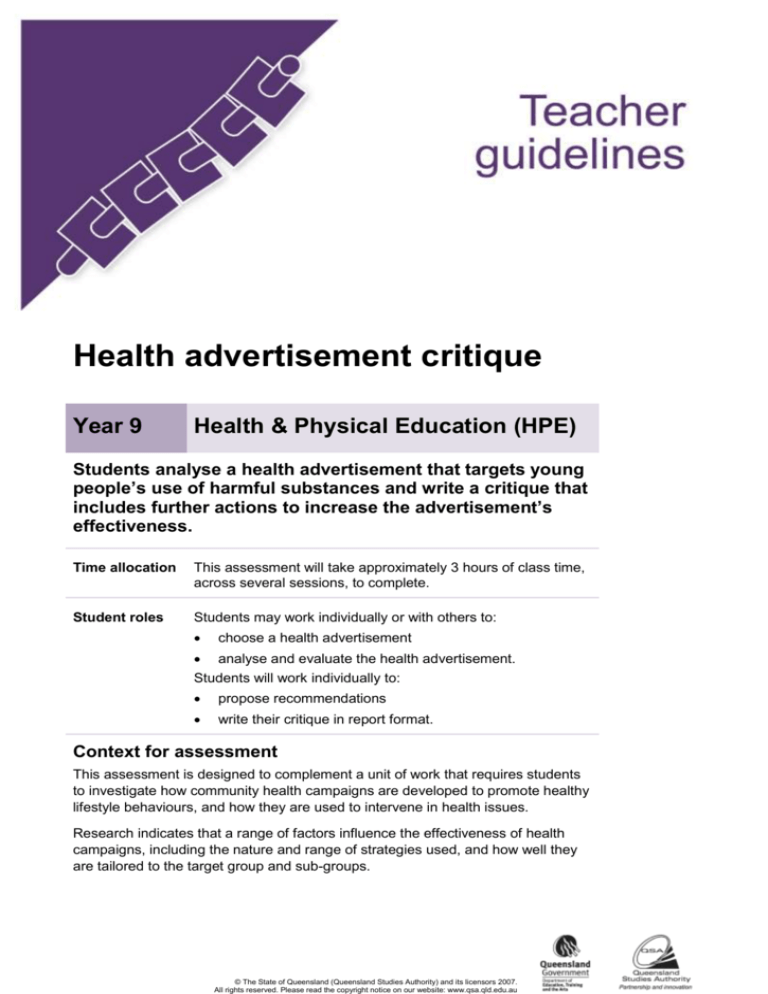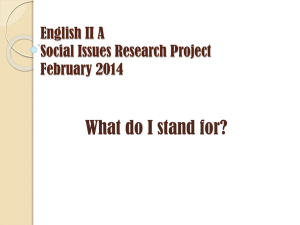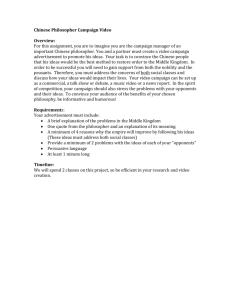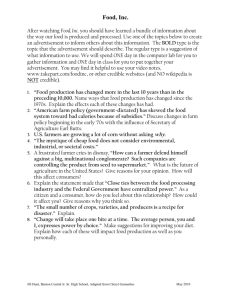
Health advertisement critique
Year 9
Health & Physical Education (HPE)
Students analyse a health advertisement that targets young
people’s use of harmful substances and write a critique that
includes further actions to increase the advertisement’s
effectiveness.
Time allocation
This assessment will take approximately 3 hours of class time,
across several sessions, to complete.
Student roles
Students may work individually or with others to:
choose a health advertisement
analyse and evaluate the health advertisement.
Students will work individually to:
propose recommendations
write their critique in report format.
Context for assessment
This assessment is designed to complement a unit of work that requires students
to investigate how community health campaigns are developed to promote healthy
lifestyle behaviours, and how they are used to intervene in health issues.
Research indicates that a range of factors influence the effectiveness of health
campaigns, including the nature and range of strategies used, and how well they
are tailored to the target group and sub-groups.
© The State of Queensland (Queensland Studies Authority) and its licensors 2007.
All rights reserved. Please read the copyright notice on our website: www.qsa.qld.edu.au
Teacher guidelines
This assessment gathers evidence of learning for the following Essential Learnings:
HPE
Essential Learnings by the end of Year 9
Ways of working
Knowledge and understanding
Students are able to:
Health
Health is multidimensional and dynamic, and
influenced by actions and environments.
research, analyse and evaluate data,
information and evidence
propose, justify, implement and
monitor plans or actions to achieve
goals, address inequities and
promote health and wellbeing,
movement capacities and personal
development.
Individual, group and community action, that
enables people to adopt health promotion
strategies, can address inequities and promote
health and wellbeing, including safety.
Assessable elements
Knowledge and understanding
Investigating
Planning
Source: Queensland Studies Authority 2007, HPE Essential Learnings by the end of Year 9, QSA, Brisbane.
2
Year 9 HPE: Health advertisement critique
Listed here are suggested learning experiences for students before attempting this assessment.
Research the incidence of and effects of substance use (e.g. alcohol, tobacco, other drugs)
among young people.
Analyse how personal (e.g. knowledge, beliefs, values, habits), social (e.g. peers, laws,
education, campaigns), cultural (e.g. family values) and environmental (e.g. availability, social
atmosphere) factors can influence use, including abstinence.
Draw concept maps to illustrate the relationships between substance use, influencing factors
and potential health outcomes.
Identify and evaluate a range of interventions, including advertisements.
Research the effects of various campaigns/advertisements used to influence young people and
to improve health outcomes.
Propose criteria for “what makes a good health intervention?”
Investigate strategies used in advertisements.
Examine structures and guidelines for developing and writing health advertisement critiques.
3
Teacher guidelines
Preparing
School policies
Teachers need to be aware of and observe school authority policies that may be relevant to this
assessment, in particular those policies relating to sensitive issues such as substance use.
Implementation
Read and discuss the assessment with your class.
Support students by referring them to, and/or providing, relevant resources — for example,
recordings of health advertisements that target substance use among young people, and
research on the impact of advertising campaigns on people’s use of substances (refer to the
Resources in these Teacher guidelines).
Discuss the structure for developing a health advertisement critique (refer to the Guide to
writing health advertisement critiques in the Student booklet).
Insist that students do not base their critique on the advertisement used in class learning
experiences.
4
Year 9 HPE: Health advertisement critique
Resources for the assessment
The references below provide links to advertisements such as television and radio commercials
and posters, and other articles that can support student completion of the assessment.
Australian Government, Department of Health and Ageing, Australian National Tobacco
Strategy 2004–2009, accessed 14 Feb 2008,
<www.health.gov.au/internet/wcms/publishing.nsf/Content/phd-pub-tobacco-tobccstrat2cnt.htm>.
Australian Government, Department of Health and Ageing, National Alcohol Campaign,
accessed 14 Feb 2008, <www.alcohol.gov.au>.
Australian Government, Department of Health and Ageing, National Drugs Campaign [home
page], accessed 14 Feb 2008,
<www.drugs.health.gov.au/internet/drugs/publishing.nsf/Content/home >. (This home page
provides links to information about the National Drugs Campaign strategy, research and
campaign resources for young people.)
Australian Government, Department of Health and Ageing, Where’s your head at? National
Drugs Campaign, accessed 14 Feb 2008,
<www.drugs.health.gov.au/internet/drugs/publishing.nsf/Content/youth-home>.
Australian Government 2006, National Tobacco Youth Campaign [home page], accessed
14 Feb 2008, <www.quitnow.info.au/internet/quitnow/publishing.nsf/content/youth-lp >. (This
home page provides links to the background to the campaign, advertising materials including
television commercials, radio advertising, campaign posters and other sources.)
Center for the Advancement of Health 2004, Science Blog, “Health promotion: Can scare
tactics work?”, accessed 14 Feb 2008,
<www.scienceblog.com/community/older/1998/A/199800824.html>.
Center for Disease Control and Prevention, Community Preventive Services 2003,
Effectiveness of mass media campaigns to reduce initiation of tobacco use and increase
cessation, accessed 14 Feb 2008, <www.thecommunityguide.org/tobacco/>. (Search for
“Effectiveness of mass media”. This short article reveals that mass media campaigns are
effective when combined with other actions.)
Drug and Alcohol Services South Australia [home page], accessed 14 Feb 2008,
<www.dassa.sa.gov.au>. (Select “Publications”, then “Alcohol” to access a range of alcohol
publications.)
The National Clearinghouse for Alcohol and Drug Information (NCADI) [home page], accessed
14 Feb 2008, <www.druginfo.adf.org.au>. (Select “Alcohol and drug info”, then “Free
resources” to access a range of fact sheets, pamphlets and reports.)
NSW Health, Save A Mate Campaign, accessed 14 Feb 2008, <www.saveamate.org.au>.
Queensland Government, Alcohol Tobacco and Other Drugs Branch, Queensland Drug
Strategy 2006–2010, accessed 14 Feb 2008, <www.health.qld.gov.au/atods>.
Queensland Government, Alcohol Tobacco and Other Drugs Branch, Young Women and
Alcohol Campaign, accessed 14 Feb 2008,
<http://www.health.qld.gov.au/atods/programs/alcohol.asp>.
5
Teacher guidelines
During the learning process, you and your students should have developed a shared
understanding of the curriculum expectations identified as part of the planning process.
After students have completed the assessment, identify, gather and interpret the information
provided in student responses. Use only the evidence in student responses to make your judgment
about the quality of the student learning. Refer to the following documents to assist you in making
standards-referenced judgments:
Guide to making judgments
Indicative A response
Sample responses (where available).
For further information, refer to the resource Using a Guide to making judgments,
available in the Resources section of the Assessment Bank website.
Evaluate the information gathered from the assessment to inform teaching and learning strategies.
Involve students in the feedback process. Give students opportunities to ask follow-up questions
and share their learning observations or experiences.
Focus feedback on the student’s personal progress. Emphasise continuous progress relative to
their previous achievement and to the learning expectations — avoid comparing a student with
their classmates.
For further information, refer to the resource Using feedback, available in the
Resources section of the Assessment Bank website.
6








